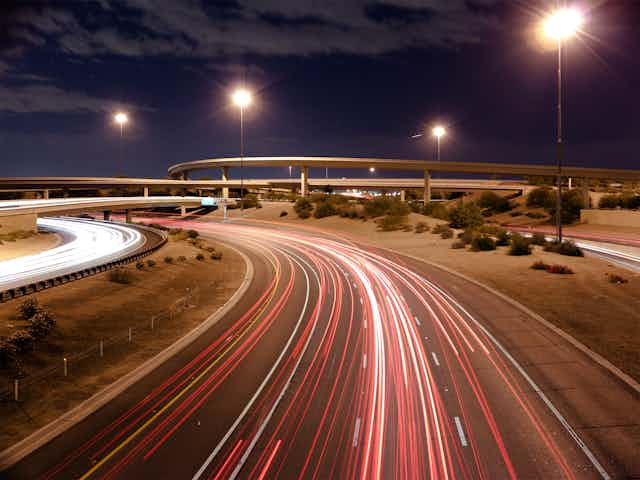Australia is gearing up for self-driving cars, or autonomous vehicles, and doesn’t want to be left behind in this so-called disruptive innovation.
Autonomous vehicles are being spruiked as the solution to peak hour congestion in terms of their economic benefits along with a lesser value of reduced road accidents. The attraction is that they will save time and human lives.
But will they be significant improvements or just facilitate our ongoing car dependence that is an even bigger economic problem?
Saving time?
A few numbers can help put autonomous vehicles in perspective. In the table below you can see the number of people who can be carried down a lane of traffic.
Assuming autonomous vehicles were one metre apart and travelling at 100 kilometres per hour (an aim that has been stated as the ultimate hope) this would mean around 25,000 people per hour could be taken down a freeway lane. While impressive, this movement capacity is only half that of a train.
But getting to this capacity means 100% of vehicles are under control of a guidance system, with none under independent control. As soon as one car does this, the whole system would slow down considerably, as is seen on freeways now.
To avoid this would require removing the ability of people to take over their vehicles and imposing a total ban on driver freedom. Otherwise, the freeway would become not much better than at present, where at peak times cars crawl along with around two-metre gaps between cars, or at higher speeds with larger space between vehicles. This is not saving much time. While individual autonomous cars may take up less space, cars overall are less spatially efficient than public transport, especially trains.
The guidance system needed to manage autonomous cars on a freeway could also apply to public transport. Buses and trains could use the same technology to upgrade their signalling systems and go much faster and closer together than anything yet seen in our cities. Buses crawling down a corridor could be simply transformed into a Bus Rapid Transit system with one-metre spacing in a long convoy very similar to a train.
Train signalling could be transformed and this could lead to capacities of around 100,000 people per hour being taken down a rail line. One train line would thus be able to carry 50 times what a present freeway lane carries. It would mean that Australian cities could manage significantly higher numbers of commuters on existing train lines. This would be massive savings in time and costs compared to whole new train lines being built down crowded rail corridors.
Autonomous vehicles also need to slow down to enter freeway exits. These would need to be lengthened to avoid pile-ups and slow traffic flow, however the substantial land required would be politically and financially difficult to find. Without such extensive off-ramps freeways will be as slow as they are now at peak time.
Considering these significant problems, we are unlikely to see autonomous vehicle freeways. Like the dream of all freeways they will in reality remain stuck in traffic at peak times with or without autonomous vehicles.
Safer?
Another spruiked benefit of autonomous vehicles is increased safety. Brendan Gogarty has written on The Conversation that the record in testing is certainly not fail safe. He shows that:
human error is perhaps the most problematic issue facing autonomous cars. This applies not only to drivers but also other road users. Roads are not isolated places, nor are they restricted to car use.
Autonomous trains have been around for 30 years and have a very good track record. That’s because they don’t require humans suddenly being able to intervene. Nor do they have a chance of harming others as they are completely isolated on separate tracks. But autonomous cars present both these problems.
The need to remove all human intervention is a real issue for autonomous freeways. Unless this is done traffic flow will constantly be interrupted by those wanting to take over control to get out of the column or through some preference or panic.
When autonomous vehicles want to leave the freeway, they will be in a much less predictable space, one that is shared with vehicles, cyclists and pedestrians that are not under any kind of control system. The likelihood of accidents in this space is high unless autonomous vehicles are tuned to react beyond anything yet imagined. This would likely result in highly sensitive autonomous vehicles that will be crawling along reacting to every little movement.
What are we left with? Not much really. In terms of time savings and safety, autonomous vehicles will not be a disruptive innovation to urban transport systems. So what potential use is there for autonomous vehicles?
Getting that ‘first mile’
The new urban economics movement shows that cities can save time and reduce road accidents if they spend their precious infrastructure resources on fast rail that can go around, under or over traffic, and create highly walkable, pedestrian-friendly city centres and sub-centres.
It means that new rail lines and new centres need to be built deep into car-based suburbs struggling to find a disruptive transport system. We need to think about how autonomous vehicles can help in this transition.
Autonomous vehicles will need to be banned from city centres that are prioritising pedestrians. But, out in the suburbs, there will be increasing numbers of people who need help getting to the nearest train station so they can travel quickly across the city, then at the other end with the short distance to a destination.
This is the “last mile” or “first mile” issue in public transport planning. Solutions have involved buses, bikes and car drop-offs but could include autonomous vehicles.
Autonomous vehicle “taxis” could find an important niche with their demand-responsive system. Such vehicles could be electric along with the trains making an oil-free, equitable and efficient system.
Now, that would be disruptive.

